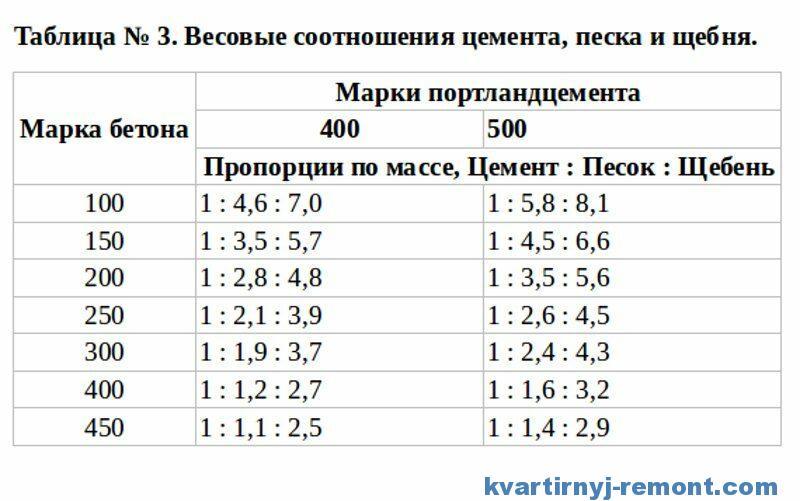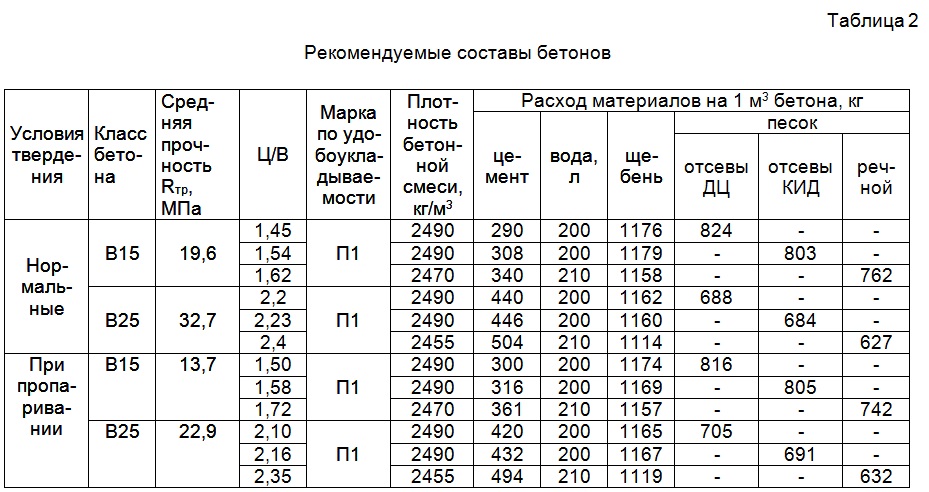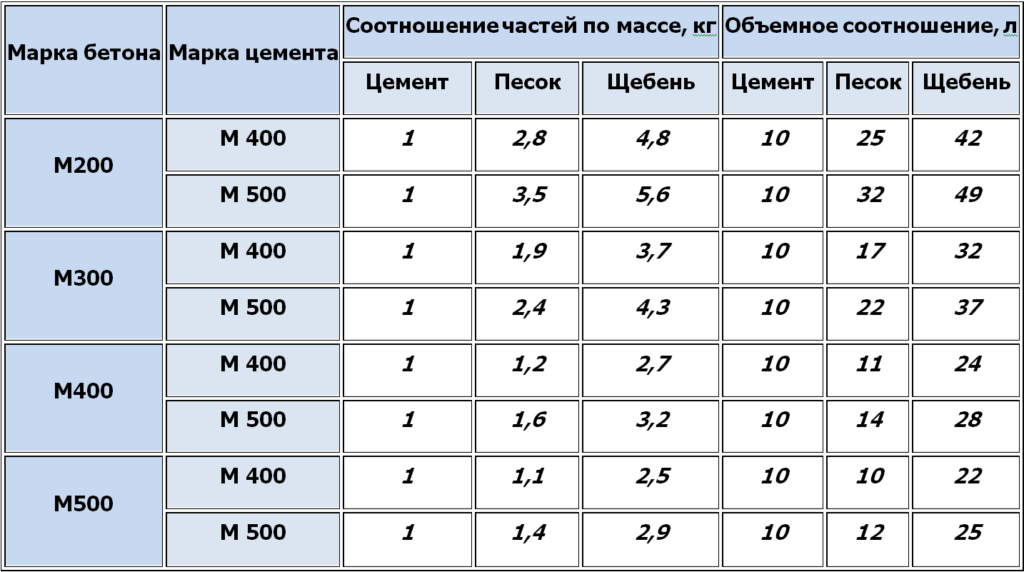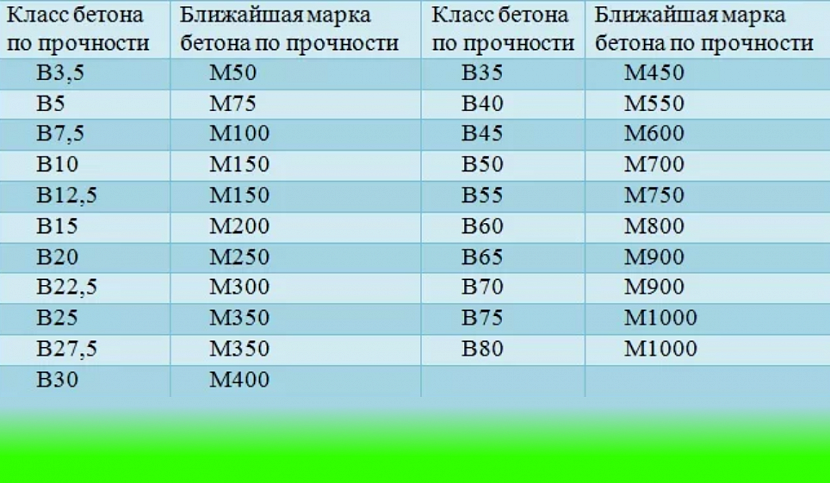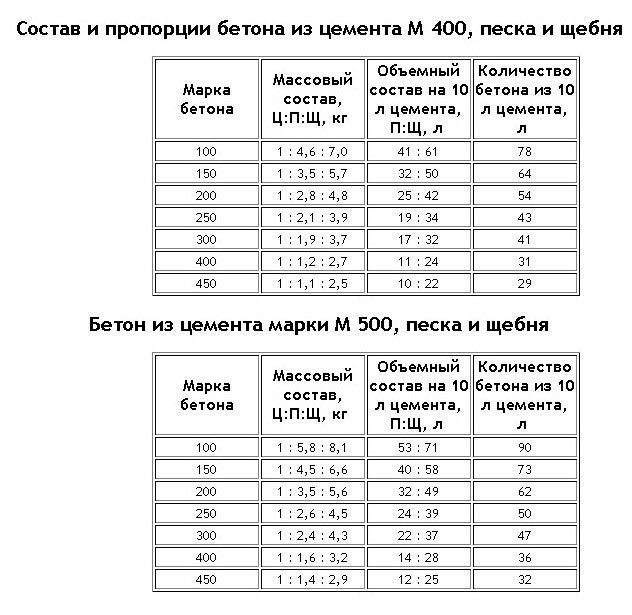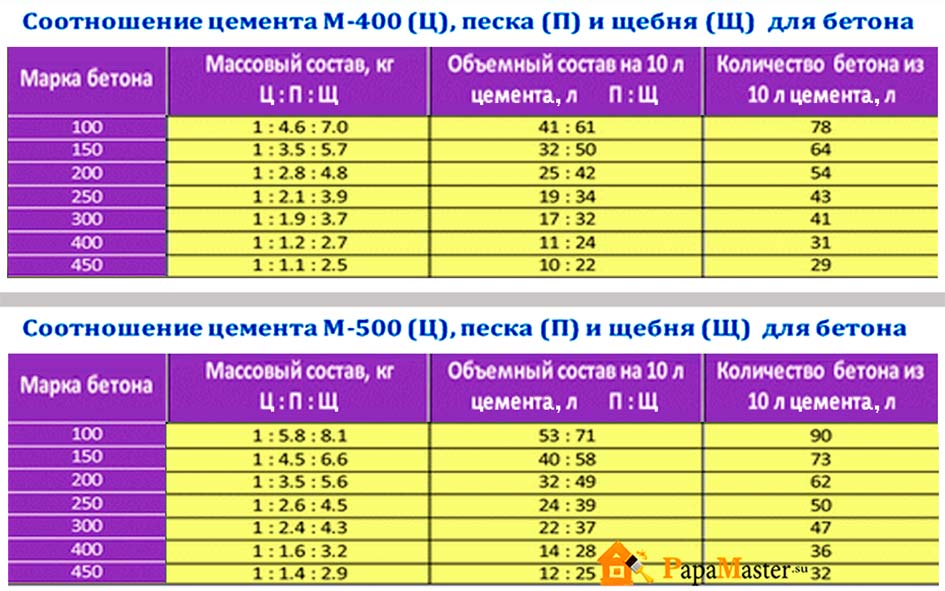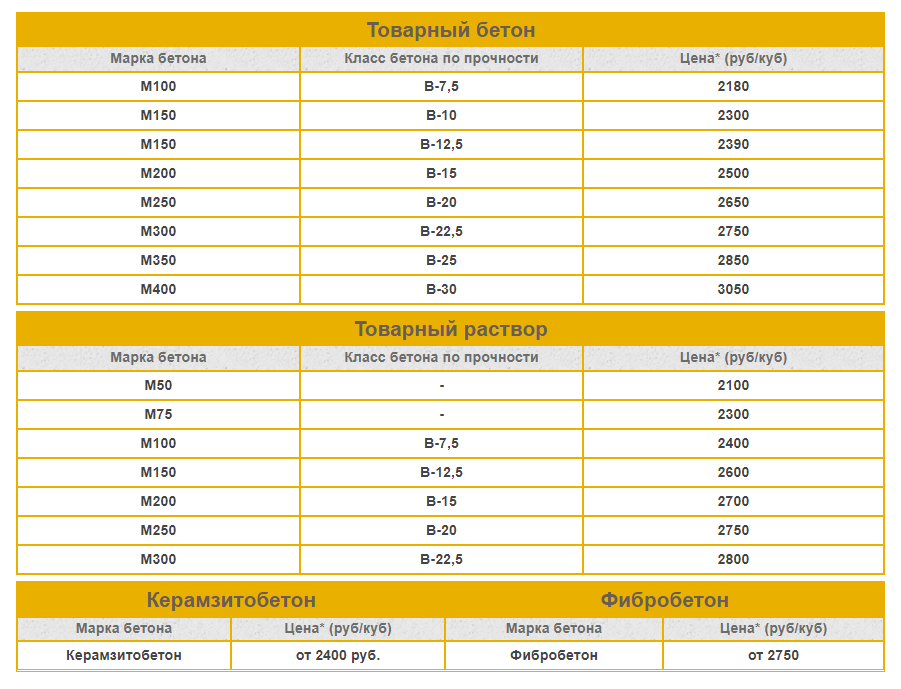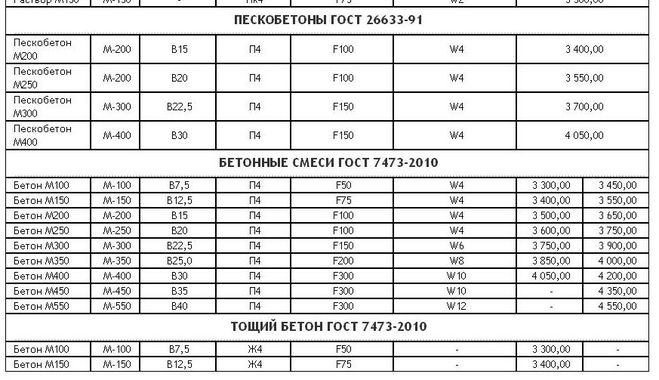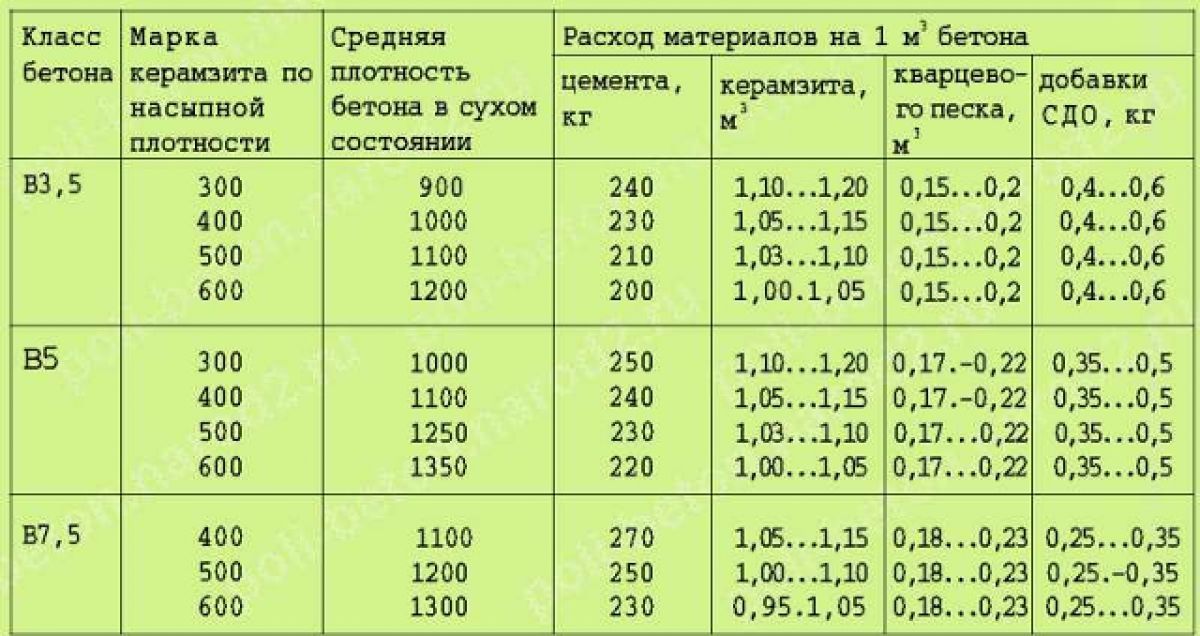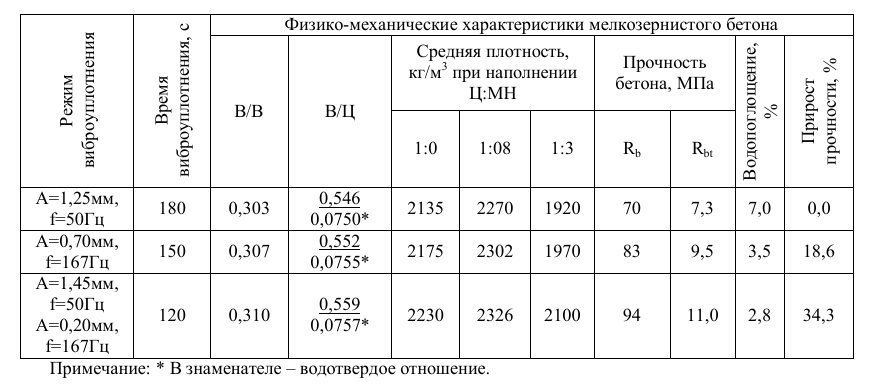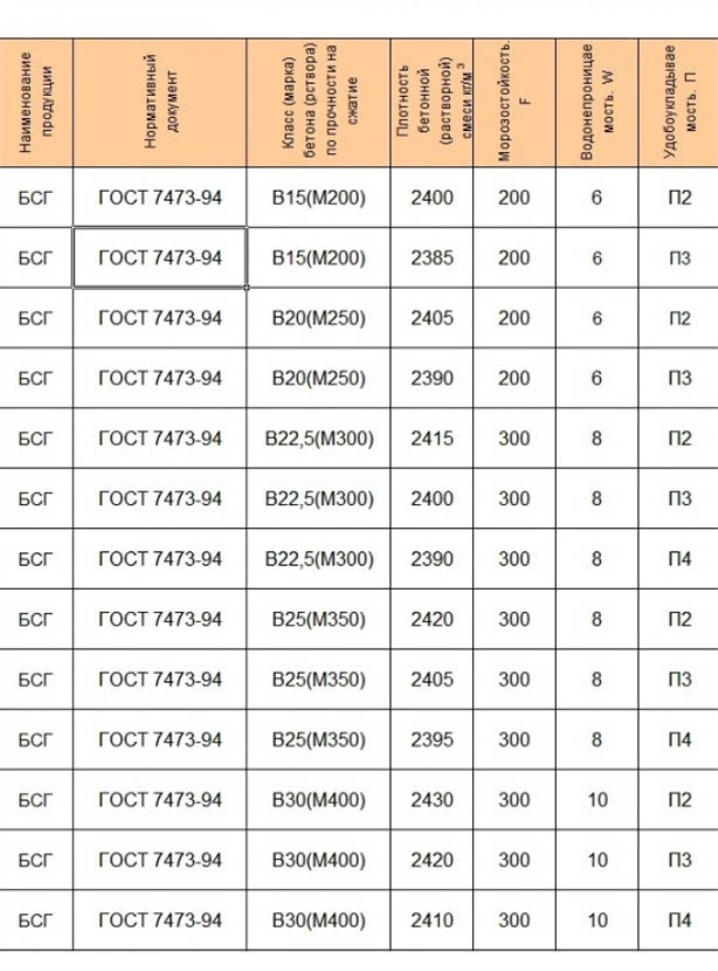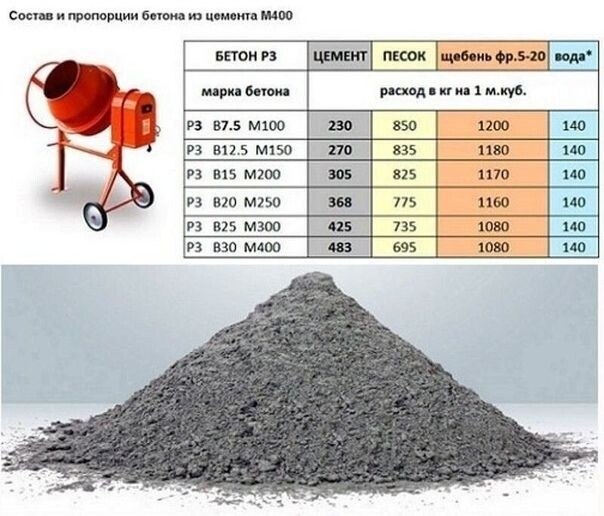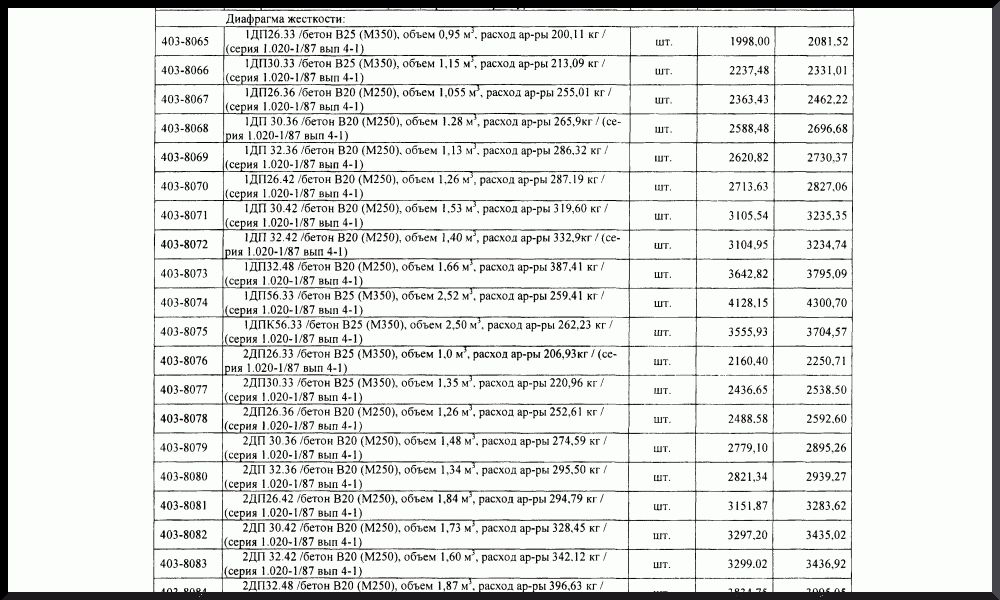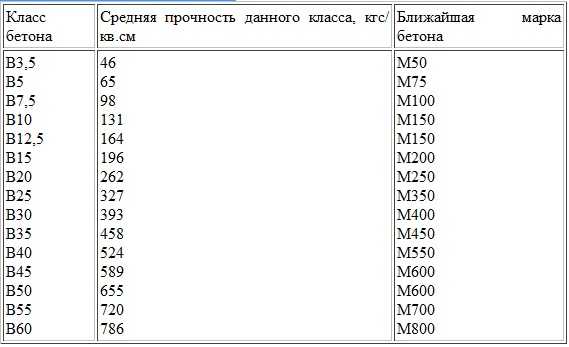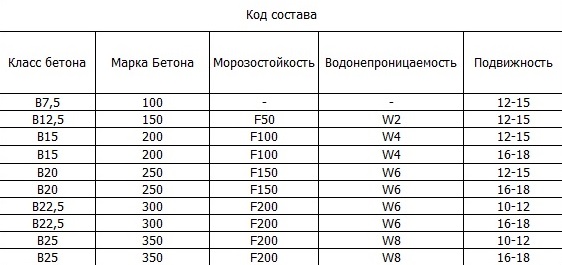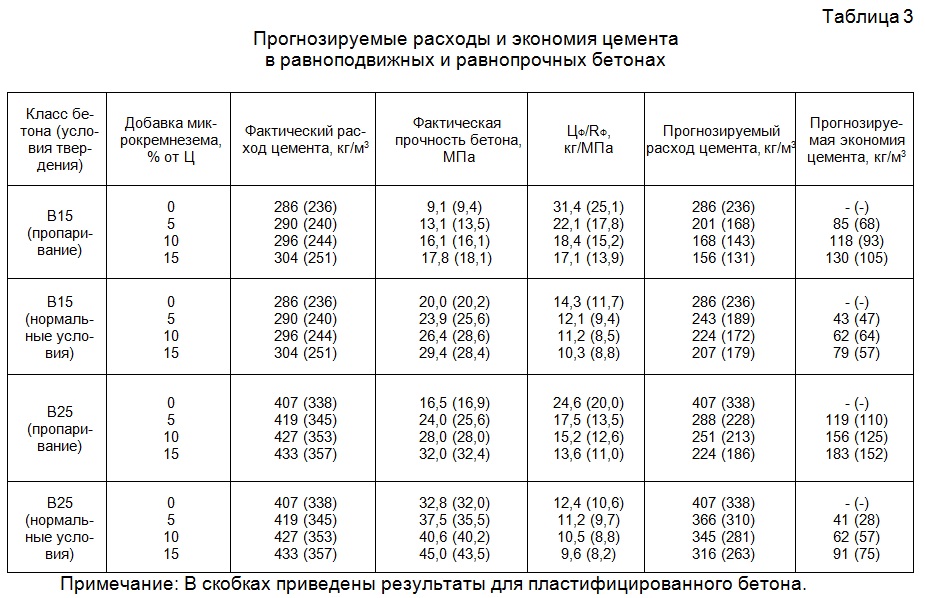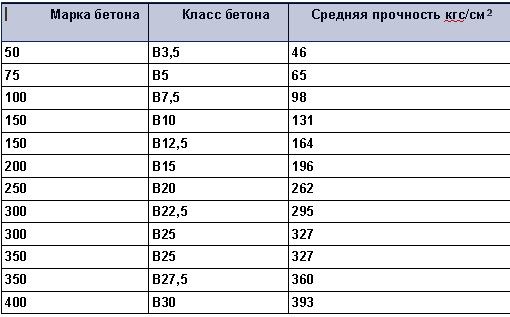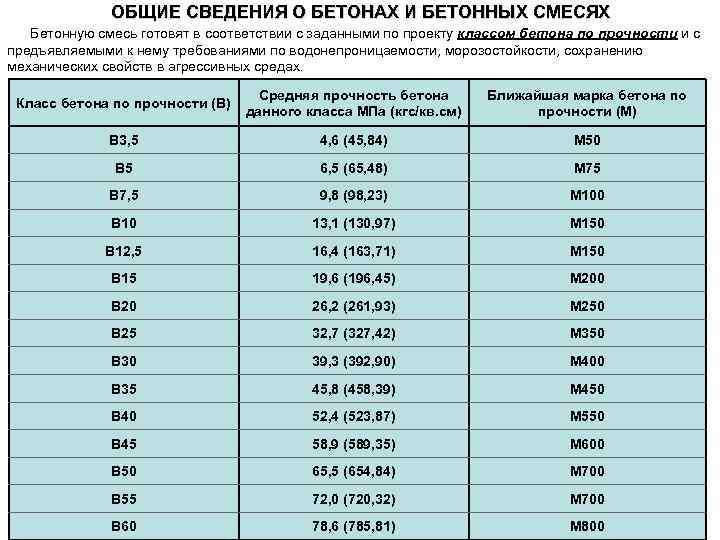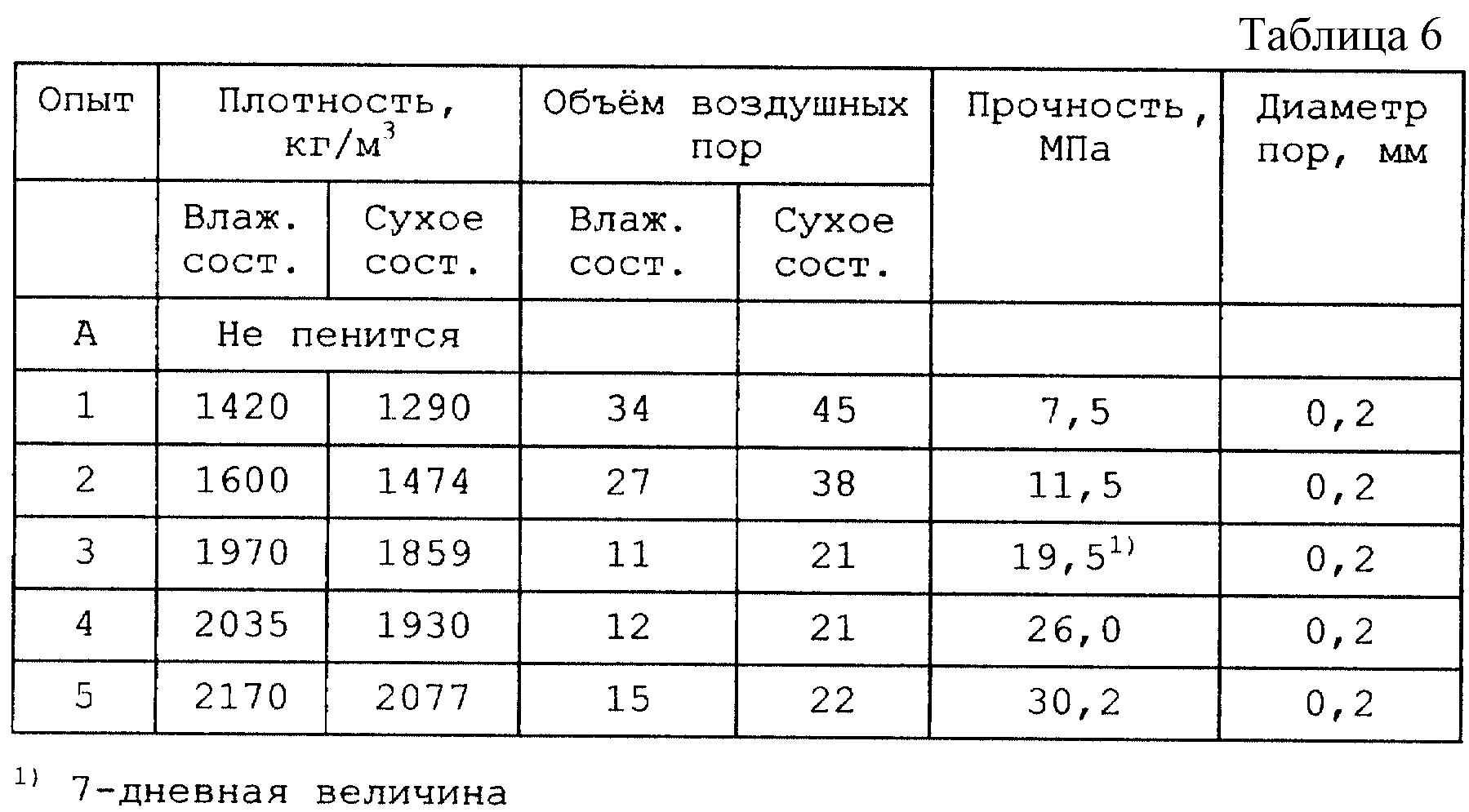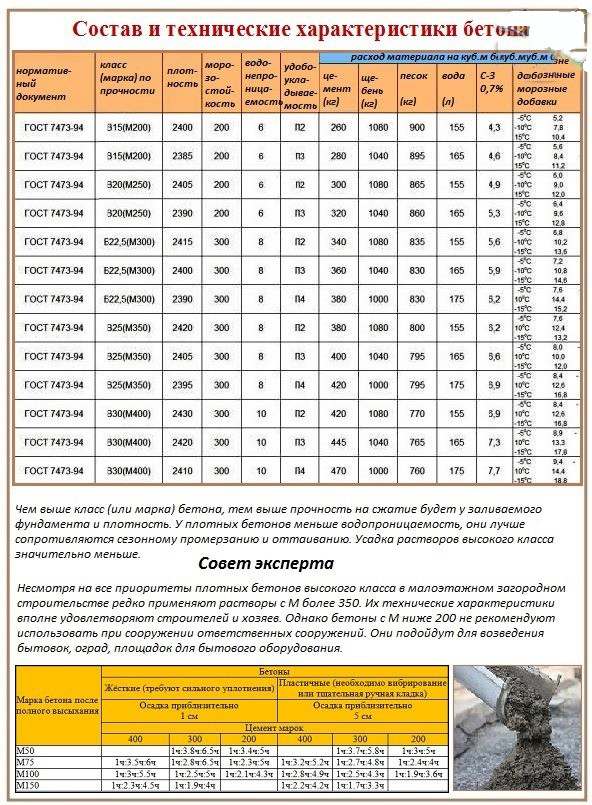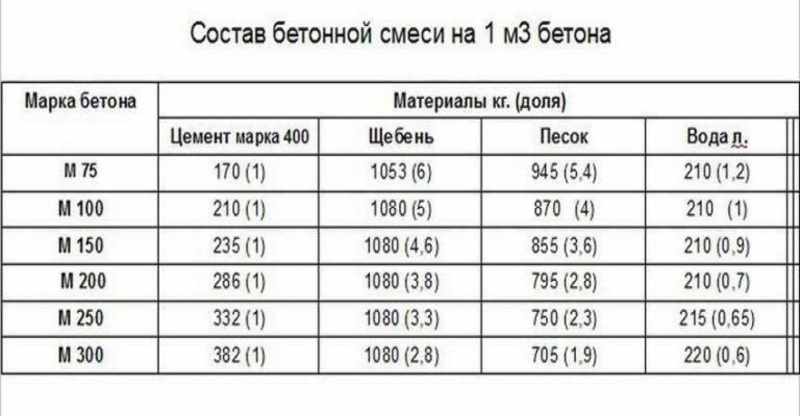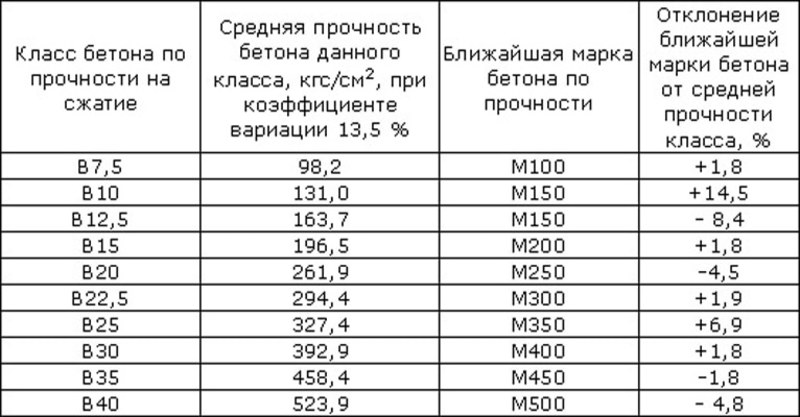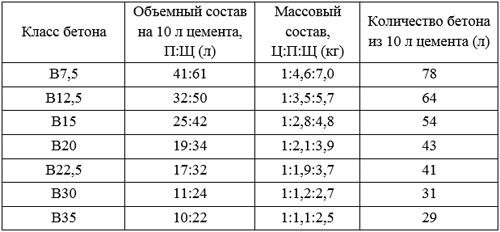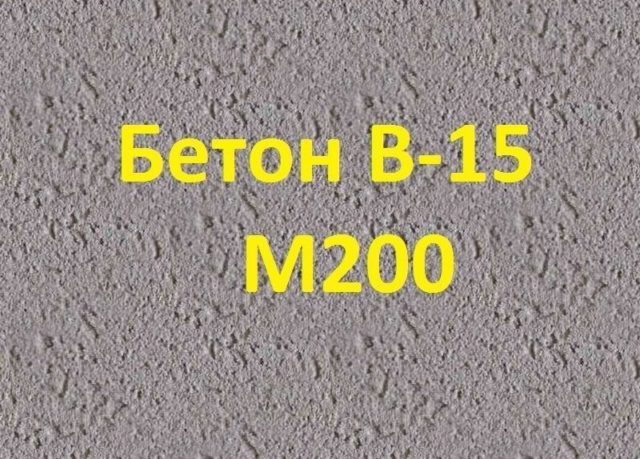Concrete composition tables.
|
№ |
Component name |
Number of components |
Density of concrete kg / m3 |
Concrete grade kg / m3 |
Empty-solid stone grade kg / m3 |
|
Concrete on sand and gravel. |
|||||
|
1 |
Cement. Kg |
240 |
2200 |
130 |
80 |
|
2 |
Cement. Kg |
200 |
2100 |
150 |
90 |
|
3 |
Cement. Kg |
200 |
1900 |
130 |
75 |
|
4 |
Cement. Kg |
200 |
1900 |
85 |
50 |
|
5 |
Cement. Kg |
200 |
2300 |
170 |
100 |
|
Waste concrete brick |
|||||
|
6 |
Cement. Kg |
230 |
1800 |
100 |
60 |
|
LIGHTWEIGHT CONCRETE |
|||||
|
Expanded clay concrete |
|||||
|
7 |
Cement. Kg |
250 |
1000 |
50 |
30 |
|
8 |
Cement. Kg |
220 |
950 |
90 |
30 |
|
Ash concrete |
|||||
|
9 |
Cement. kg Ash coal or slate. m3 (kg) Water. l |
200 1.2 (960) 90…130 |
1200 |
50 |
30 |
|
10 |
Cement. Kg |
220 |
1500 |
60 |
35 |
|
11 |
Cement. Kg |
9O ... 13O |
1500 |
120 |
70 |
|
Expanded clay-ash concrete |
|||||
|
12 |
Cement. Kg |
200 |
950 |
50 |
30 |
|
Slag concrete |
|||||
|
13 |
Cement. Kg |
200 |
950 |
75 |
45 |
|
14 |
Cement. Kg |
200 |
1250 |
100 |
60 |
|
15 |
Cement. Kg |
200 |
1300 |
75 |
45 |
|
16 |
Cement. kg Boiler slag. m3 (kg) Sand quartz. m3 (kg) Water. l |
200 0.8 (720) 0.32 (540) 90…130 |
1450 |
100 |
60 |
|
Ash and slag concrete |
|||||
|
17 |
Cement. Kg |
200 |
1250 |
75 |
45 |
|
Sawdust concrete |
|||||
|
18 |
Cement. kg Sawdust. m3 (kg) Sand quartz. m3 (kg) Water. l |
260 0.6 (150) 0.65 (!!00) 100…150 |
1500 |
50 |
30 |
|
19 |
Cement. Kg |
280 |
1760 |
70 |
40 |
|
20 |
Cement. Kg |
230 |
1000 |
50 |
30 |
|
Expanded clay-sawdust concrete |
|||||
|
21 |
Cement. Kg |
280 |
880 |
45 |
25 |
|
22 |
Cement. Kg |
280 |
1350 |
60 |
35 |
|
Ash mill concrete |
|||||
|
23 |
Cement. Kg |
230 |
1500 |
50 |
30 |
|
24 |
Cement. Kg |
230 |
1750 |
70 |
40 |
|
25 |
Cement. Kg |
260 |
1000 |
60 |
35 |
|
Claydite-ash-sawn-off concrete |
|||||
|
26 |
Cement. Kg |
220 |
1300 |
60 |
35 |
|
Perlite concrete |
|||||
|
27 |
Cement. Kg |
280 |
1200 |
50 |
30 |
|
Polystyrene concrete |
|||||
|
28 |
Cement. Kg |
250 |
1250 |
45 |
25 |
|
COMPOSITION GYPSUM-BASED |
|||||
|
Gypsum concrete |
|||||
|
29 |
Gypsum G-5. kg Fly ash TPP. m3 (kg) Sand quartz. m3 (kg) Water. l |
320 0.1 (80) 0.75 (1300) 210 |
1700 |
125 |
75 |
|
30 |
Gypsum G-5. Kg |
380 |
1600 |
110 |
65 |
|
Gypsum concrete |
|||||
|
31 |
Gypsum G-5. Kg |
540 |
1150 |
50 |
30 |
|
32 |
Gypsum G-5. Kg |
540 |
850 |
40 |
25 |
|
Gypsum aggregate concrete |
|||||
|
33 |
Gypsum G-5. Kg |
430 |
1000 |
70 |
45 |
Composition and proportions of the mixture
Concrete of the m350 brand belongs to the elite categories of building mixtures. It is intended for the construction of buildings with high physical, atmospheric and mechanical stress. Compressive strength characteristics are especially high. In many respects, such high properties are provided by the correctly selected mixture composition.
F100 concrete contains cement, water, gravel, sand, anti-freeze and plasticizing additives. Each ingredient differs in strength characteristics, grain size and other important parameters:
- It is allowed to use sand with any grain size: coarse, fine and medium.
- It is possible to use crushed stone or gravel of granite or calcareous origin.
The fast hardening property is provided by the high content of Portland cement in the B25 mortar. Ready-mix concrete M350 is obtained from Portland cement at least M400. For 10 kg of the mixture, the consumption of the aggregate will be: 15 kg of sand plus 31 kg crushed stone. If the cement grade M500 is available, then 10 kg of dry mix will have 19 kg of sand and 36 kg of crushed stone.
Converting from mass units to volumetric ones:
- 10,000 cc concrete B20 from cement M400, you should take 14 liters of sand and 28 liters of crushed stone;
- for 10,000 cc concrete f100 from the M500 cement grade requires a consumption of 19 liters of sand and 36 liters of crushed stone.
Concrete composition M350. When calculating the proportions for a volume of 1m3 in mass terms, you will need:
- 400 kg of 500th cement;
- 752 kg of refined sand;
- 1000 kg of crushed stone or gravel;
- 175 liters of water.
What will be the B25 mixture, you can judge the proportion. To what rigor it is observed, how thoroughly the ingredients are mixed, the homogeneity of the mass depends. If the conditions are not met, there will be undesirable losses in the strength of the finished concrete mass, which will reduce the technical and operational indicators of the structure being erected.
Laying rules
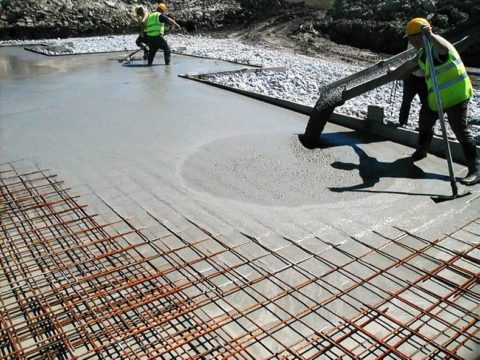 Laying the sub
Laying the sub
During the installation of the WMS, the following recommendations should be taken into account:
- It is necessary to ensure a continuous supply of material to the installation site. Make sure that after unloading the solution from one mixer, proceed to emptying the next.
- Strictly control the delivery time of the material to the construction site.
- Before pouring concrete, make sure that there is no water in the formwork. The presence of excess water can provoke delamination.
- The length of the pipeline for pumping the solution should be no more than 200 m (see photo).
 Concrete pump pipeline
Concrete pump pipeline
- Concrete supplied through pipelines does not require additional compaction.
- Concreting of thin-walled building structures, where self-removal of air bubbles is hampered by technical conditions (formwork of complex geometric shape, columns of small diameter), the solution should be supplied through the lower branch pipe of the frame formwork.
Self-compacting concrete mixes are materials with unique physical and mechanical properties. Their production became possible due to the combined use of highly effective superplasticizers and active mineral additives.
Main characteristics
According to the classification, B35 concrete belongs to structural ones, it is used for critical elements. The technical parameters of the material are necessarily examined in the laboratory. Compliance of the characteristics with the standard is checked in accordance with GOST 10180-2012 and 7474-2010.
The concrete mix in production is tested for the following qualities:
- Mobility - the workability of the solution depends on it. For B35, the standardized indicator is 10-25 cm of cone draft, which corresponds to grades P3-P5.
- Stiffness is the vibration time for the moment of filling a special form. For class B35 concretes, the characteristic is 21-40 s, marked as Zh3-Zh4.
After 28 days, the samples are subjected to a series of tests, during which it is determined:
- density - depending on the characteristics of the aggregate, it ranges from 2500 to 3000 kg / m³;
- strength - for the M450 brand not less than 458 kg / cm²;
- frost resistance - determined by design requirements, regulated by the use of additives, usually not lower than F300;
- water tightness - W8-12, for underground and hydraulic structures W14.
For structures subject to abrasion, the abrasion grade is determined once every six months. B35 concrete must comply with G1, G2.
Additives of plasticizers change the properties of concrete - they increase the density, water resistance, frost resistance, improve workability, and extend the life of the mortar.
Scope of application
High-strength concrete, starting from B25, is used for prefabricated and monolithic frame elements, reinforced concrete structures of buildings - floor slabs, columns, girders, trusses and crane beams. Concrete B25 (M350) and higher classes are used for the manufacture of monolithic foundations, pile-grillage concrete structures, bathtubs, walls of pool bowls. Heavy super-strong compounds are used in road construction for the construction of bridges and tunnels. B25 (M350) concrete is well suited for the construction of airfield runways, which must withstand prolonged cyclic loads.
The use of such concrete is regulated by SNiPs and GOSTs related to work on the manufacture of reinforced concrete products. When concreting, vibration compaction must be used. To do this, when pouring prefabricated structures in the factory, stationary vibration stands or vibration platforms should be used, and for monolithic ones, vibrators with a flexible shaft should be used.
In addition to the wide use of the B25 class in industrial construction, it can be recommended for the construction of individual residential buildings.
It is necessary to prepare such a composition with careful adherence to the recipe. However, in order to prevent unforeseen and force majeure situations, it is better to order the mixture at mortar-concrete units, where input quality control of materials is mandatory, as well as verification of the resulting products. Upon delivery, the seller is fully responsible for the quality of the solution and the conformity of the characteristics.
Concrete weight depending on its grade
The table below, kg m3, shows the approximate weight of the material, depending on its grade. Simply put, this is the average density of concrete.
The labeling of the mixture is always indicated in the regulatory documentation.
The most common brands:
- M100. Used in many preparatory work. For example, for arranging the preparation of a layered pillow before pouring a monolithic or prefabricated foundation. It is also used to make the basis for laying curbs in the process of road construction. The density of concrete m100 is in the range of 2.33 - 2.35 t / m3.
- M150. It is used to make the foundation for light buildings: sheds, garages, etc. It is also used as a base for highways. M150 concrete is also used for pouring screeds under some floor coverings. The density of concrete m150 varies in the range of 2.36 - 2.37 t / m3.
- M200. The most popular mixture in many areas. It is considered heavy, since its specific gravity is 2375 kg / m3 of concrete. It is characterized by an optimal balance of strength, frost resistance, quality and cost. It is used to make a foundation, paths for pedestrians, sidewalks, flights of stairs, slabs and other concrete products. The density of concrete m200 is 2.37 - 2.39 t / m3, so it is able to withstand strong pressure drops.
- M250. M250 concrete is virtually identical in properties to the marking described above, but it is more durable. Thanks to this material, it is possible to make slabs with a high load-bearing capacity. Therefore, concrete m250 is quite popular in construction.
- M300. This material is suitable for pouring foundations, walls, staircase fences. The density of concrete m300 varies in the range of 2.4-2.41 t / m3.
- M350. This material is characterized by great strength, therefore, complex structures, pools and runways at airports are made from it. The density of concrete m350 is 2.42-2.43 t / m3, and the average density of concrete m350 is greater than that of the material M400.
- M400. This solution is used in the manufacture of various beams, piles, lintels and other elements of the supporting structures of buildings. I also make dams, tunnels, bridges, collectors, etc. from it. The density of concrete m400 averages 2.43 t / m3.
The brand is considered one of the main parameters of this material, because it reflects its ability to perform various functions.
It is because of this that the first thing to do is to pay attention to the brand of solution at the time of purchase.This material has many different characteristics: mobility, water resistance, frost resistance, etc.
But they often fade into the background.
The strength of the mixture during hardening changes: it does not reach its maximum value immediately, but only after the end of the hardening period (28 days). For example, four days after the foundation is poured, it will be one, and after 8 days another. During this period, it can gain 70% strength. Strength does not stop even after 28 days, because after 6 months it becomes even more.
Cooking proportions
For the preparation of concrete grade M400, a standard set of materials is used, which are mixed in the appropriate proportion. Cement M500 and M400 can be used in production. Depending on the brand of binder, the mass fractions of the components may vary slightly. The proportions for the production of 1 m³ of concrete solution are shown in the table:
| Cement grade | Proportions
C: P: U: V |
Cement, kg | Sand, kg | Crushed stone, kg | Water, l | Concrete cube weight, kg |
| M400 | 1:1,5:2,5:0,5 | 420 | 625 | 1085 | 190 | 2315 |
| M500 | 1:1,9:3:0,5 | 357 | 675 | 1085 | 190 | 2304 |
Knowing the exact ratio of the components, you can accurately calculate the amount of materials and production costs to produce the right amount of concrete. It is known that the cost of one cube of this building material is 3700-4300 rubles. This will make it possible to more accurately calculate the economic component of the project. To increase the mobility of the mixture, it is not recommended to use more water; for this, special plasticizers are used, which will require about 7.5 kg. To obtain full compliance with the declared quality, it is better to order this material at a concrete plant. At the same time, it is necessary to strictly adhere to the delivery and laying schedule of this material, since it quickly sets.
But in small or private production, volume fractions are used for the manufacture of concrete mixture. In this case, the standard bucket is most often used as a measure, the volume of which is 10 liters. In order to make one cubic meter of concrete M400, you will need the following number of components:
- Portland cement M400 - 32.3 buckets;
- Refined river or quartz sand - 41.7 buckets;
- Gravel or granite crushed stone - 80.4 buckets;
- Water without salts and organic impurities - 19 buckets.
Based on this proportion, you can find out the number of buckets for any volume of concrete. For example, to prepare 100 liters or 10 buckets of mortar, the number of buckets of cement, sand, gravel, water just needs to be divided by 10. You can mix the mortar using a concrete mixer or manually using a suitable container and a shovel. In both cases, it is necessary to achieve the most homogeneous mixture of thick sour cream consistency.
Often, portable concrete mixers are used to make concrete in private construction or in small industries. At the same time, cheaper cement M400 is purchased. A standard tank of such a mixer holds about 150 liters, but in order to avoid losses during manufacture, it is filled no more than two-thirds, which is 100 liters. To make such an amount of concrete M400 or B30, you will need to take:
- Cement M400 - 3.2 buckets;
- Sand - 4.2 buckets;
- Rubble - 8 buckets;
- A little less water - 2 buckets.
After thorough mixing, a plastic mixture is obtained, ready for use, in all respects corresponding to concrete M400. In the manufacture of this material, precise proportions are required so as not to degrade its characteristics. At the same time, you need to be aware that after complete curing for 28 days, the monolith will be resistant to processing; diamond discs and drills will have to be used for cutting or drilling it.
The proportions of concrete of different brands
This entire assortment and spectrum of qualities is obtained using the same materials, just in different quantities. To achieve the required characteristics, the recommended proportions must be strictly observed.
When building your house, you want to do everything as best as possible, and therefore, when composing concrete, there is a desire to add more cement: to make it stronger. This should not be done. It is unlikely to get better, but worse - easily. For the curing of concrete, a certain amount of water and other components is required. If there is little water, there is a lot of cement, bonds between the particles are formed in insufficient quantities, which can cause the concrete to crack and crumble. The same applies to the number of placeholders. And too much of their content, and insufficient, negatively affects the qualities of the concrete stone.
Concrete proportions are usually displayed in fractions. The amount of cement is taken as a unit, and the remaining components are prescribed in relation to it. The data are given in the form of tables for the respective brands, units of measurement are required. You can see such a table of concrete components below.
Proportions of concrete of different grades from Portland cement M400 and M500
How to determine the required proportions of concrete from this table? Find the grade of concrete you require in the second column. For example, you need an M250. Depending on which Portland cement you will use M 400 or M 500, choose one of two lines. The third column shows the proportions for concrete in kilograms: for 400 cement it is 1 / 2.1 / 3.9. This means this: to obtain concrete of the M 250 brand, for 1 kg of M400 Portland cement, 2.1 kg of sand and 3.9 kg of crushed stone must be added. In a similar way, you determine the proportions for concrete M200 - the data for it in the table are slightly higher, or concrete M 300 - slightly lower.
The fourth column shows the volume fractions: all components are given per 10 liters. They are selected in the same way.
These tables do not indicate the amount of water. It depends on how thick you need the solution. The water-cement ratio is given in separate tables. For example, below are data on the number of inputs in relation to a kilogram of cement, assuming the use of medium-sized aggregates.
The amount of water for obtaining concrete of the required grade when using crushed stone and sand of medium size
For example, to obtain concrete grade M 300, the proportions of cement M 500 and water are determined as 0.61. This means that 0.61 liters of water (610 ml) is added to the solution for 1 kg of cement. This produces a medium-plastic solution, which is used most often. > But when pouring foundations or other structures with thick reinforcement, a plastic mortar may be required. Then, when determining the amount of water, in addition to the brand of cement, it is also necessary to take into account the size of the aggregates and how fluid the solution should be. These data are presented in the table below.
The amount of water in concrete depending on the size of crushed stone / gravel and the fluidity of the solution
Sometimes it is necessary to determine how much cement you will need for a particular task. To do this, you need to know how much cement is contained in a cubic meter of concrete. You will find data on grades of concrete and cements in the table below.
The amount of cement per cube of concrete
Features and Applications
Class B15 concrete is classified as structural concrete. The bearing frames of buildings (slabs, panels, columns) that do not perform heat-shielding functions are made from it. In terms of density, B15 is heavy. In terms of the use of binders, concretes of class B15, grade M200, are made on Portland cement M400 or M500. The composition includes, in addition to cement, crushed stone, sand and water with certain properties and in proportions selected for.
For concrete stairs and pouring sites that experience temperature drops (negative and positive), use B15 concrete with frost resistance F75 or F150. Frost resistance F50 is determined by testing a sample for the ability of structures to maintain the design strength grade by 85% at 50 freeze-thaw cycles.
The foundation for the house can be made of different brands, both in terms of strength and frost resistance.The grade of the mixture for the internal bearing walls of the foundation of a heated building may not be standardized for frost resistance. This is due to the fact that the mixture of class B15 already has frost resistance. And the additional requirement for the number of cycles applies to structures that can receive 50 or 75 cycles during the entire service life.
A number of special requirements may be imposed on designs. For example, in hydraulic structures, the waterproofing mark should be at least w4. In the construction of blast furnaces, heat-resistant concrete based on Portland cement with special additives (chromite and magnesite) is used. This composition of the mixture is not destroyed at temperatures up to 1700 ° C.
The fulfillment of the concreting requirements consists of several stages:
- On concrete nodes, the future composition of the B15 brand is selected in percent.
- Prototypes are tested in laboratories for compliance with the brand strength, the data are entered in the passport.
- At the construction site, the contractor is obliged to fill in test control cubes measuring 150 x 150 x150 mm from each batch. Samples should have the same curing conditions as the main structures.
- On the 28th day, the construction organization tests control samples, the results are recorded in the work production log. The as-built documentation is presented to the customer to the Act of putting the facility into operation.
- The cube strength of the samples must be converted to the brand strength in accordance with the conversion table.
How to influence density (bulk density)
The density of this material most of all depends on the properties of the components of the solution.
That is why they need to be selected with special care in order to end up with a material of the required density. This parameter of the material is influenced by many aspects.

To obtain a solution of the required density, you need:
- Use the smallest filler. Thanks to this, it is possible to reduce the number of voids in concrete products.
- Reduce the amount of water. But it must be borne in mind that the mobility of the solution must be normal. It is difficult to work with a thick and heavy mortar, in particular when pouring structures that are complex in shape and large in size.
- Seal the mortar mechanically or manually. Sealed with vibrators or fittings.
- Artificial heating of the poured mixture. This allows moisture to evaporate faster, while increasing the mass and density of the material.
- Choose expandable or non-shrinking cement. For example, alumina cement or Portland cement can be used. Thanks to this, the material will have a small porosity, and its quality will not deteriorate.
- The use of plasticizers. The additives make it possible to reduce the amount of water required for the preparation of the solution and to preserve its mobility. This will increase the density of the material.
- Evacuation. This technological process is rather complicated, therefore it is used only in industrial production.
Advantages and disadvantages
The most important characteristics of M250 concrete are versatility and strength. It is taken as a basis for the construction of houses, bridges, overpasses, parking lots and other buildings. Also, the building material has such significant advantages:
- resistance to high temperature influences;
- moisture resistance;
- the material is not affected by mold, corrosion and other atmospheric influences;
- concrete mix is a profitable and economical material, as its cost and quality are good.
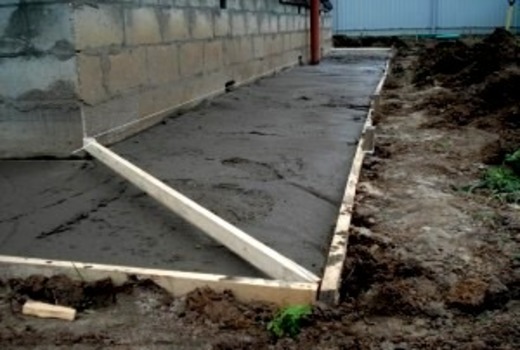
If we take into account the modulus of elasticity and compression, then the building material is quite strong, but as far as faults are concerned, it is quite brittle. For example, if a certain pressure is applied to a concrete element, it may crack. To prevent this from happening, steel reinforcement is used when pouring. Another disadvantage is a gray appearance, the surface of the structure will need to be plastered. Another disadvantage is that in the manufacture of concrete and cement mixtures, it negatively affects natural resources and the quality of air and water.
Control of compliance of the solution with class B45
The use of M600 in critical structures is accompanied by constant quality control of concrete at all stages of its production. Supervision is also carried out over the observance of the regulations for laying the mixture into the body of the structure. Checks are carried out according to the following rules:
- Acceptance of concrete is carried out in batches prepared from one raw material of an established composition using a single technology. The amount of the tested mass is determined in accordance with GOST-18105, usually the volume does not exceed the shift release of the concrete mixer.
- The workability of the solution is monitored in each batch once per shift no later than 15 minutes after manufacture and 20 - upon delivery to the consumer. From each released volume, the average density and strength of the concrete mixture is checked. Other characteristics (frost resistance, water resistance) are determined according to the technical specifications for the structures being manufactured.
- At the place of work, the acceptance of the concrete mix occurs by volume: the submerged volume is reduced by the compaction index during transportation by agreement between the manufacturer and the consumer.
- The user has the right to conduct supervisory checks of the quality and quantity of concrete solution according to the methods of GOST-10181.
The manufacturer is obliged to inform the consumer, upon his request, of the test results no later than 3 days after they were carried out. If the quality indicator does not match, a message about this is sent to the facility under construction on the same day. Today, the volume of consumption of high-quality concrete of the M600 brand with the strength class B45 is still small, but they are constantly increasing, which indicates the growth of capital construction and the country's economy as a whole.
Areas of use
In the construction and industrial field, concrete grade 200 is very popular - the proportions, in turn, directly affect the areas of application of such a mixture:
- driving foundations - for one-story and three-story private houses;
- installation of screeds both at home and in workshops, garages, on terraces;
- installation of the blind area, porch - they do not have a lot of pressure;
- production of reinforced concrete products, for example, FBS blocks, foundation pads, etc.
For the production of vibrocasting tiles, pouring sidewalk paths of this indicator is also quite enough. But, if you decide on such industrial feats on your own, it is better to play it safe and use the M300 brand.
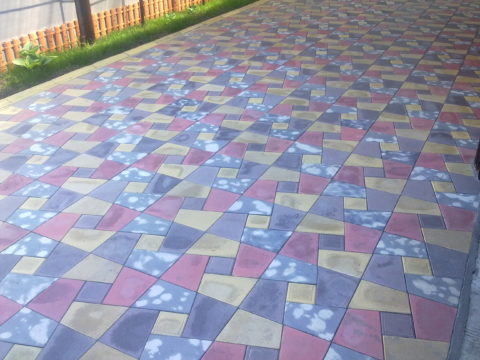 Vibrocasting tile
Vibrocasting tile
Production and transportation
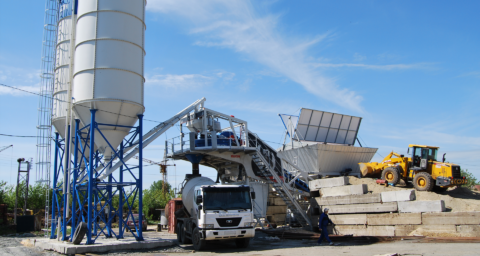 Concrete plant
Concrete plant
The preparation of self-compacting mixtures requires highly qualified personnel and specialized equipment, which does not allow to carry out its production on a construction site with your own hands. You can verify this by reading the recommendations and requirements presented below for the manufacturers of this material.
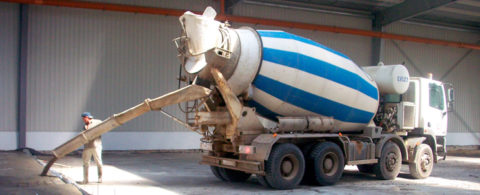 Concrete transportation
Concrete transportation
Instructions and technological requirements used in the production and transportation of commercial self-compacting mixtures:
- Ultimate dosing accuracy of materials before feeding to the mixing plant.
- Drying and moisture control of fine and coarse aggregates.
- Use of additional water only in accordance with the technical conditions provided for this concrete grade.
- Complete unloading of the drum of a mixing plant or tank of a concrete mixer, followed by a thorough rinsing of the tanks.
- Strictly follow the rules of transportation. Take into account weather conditions, air temperature - all this can disrupt the condition and design composition of the transported concrete.
- If the technological instructions provide for, or there is a need, additional addition of thinning additives at the construction site, it is necessary to strictly adhere to the recommendations of the concrete manufacturer, so as not to violate the design indicators of viscosity and flowability.
- Concrete transportation to the construction site should be carried out only by certified vehicles that have passed acceptance tests.
 Certified transport
Certified transport
Specifications
Construction standards are a set of defined rules and requirements for the design and characteristics of materials and structures. Basic technical parameters of B15 concrete according to GOST:
1) Compressive strength. A material of this class is capable of withstanding a load of 200 kg applied to 1 cm² of the surface of a concrete structure.
2) The class of concrete is also an indicator of the strength of concrete, but it comprehensively indicates the guaranteed strength characteristic of the entire structure in MPa (B15). According to SP 27.13330.2011, these markings are valid for designers and builders. To compare the two definitions of strength, class-to-grade conversion tables are used.
3) The density of concrete grade M200 (B15) is 1800-2500 kg per cubic meter. This density class is heavy.
4) Frost resistance and water resistance. These technical characteristics are indicated in the design documentation to ensure the reliability of structures. F50, F75, F100, F150, F200, F300, F400, F500 - the numbers determine the durability of structures operating at negative temperatures. Up to 4 cycles are taken during the year. W2, W4, W6, W8 and W12 - the water resistance of the cylinder is 15 cm at a pressure of 2.4, 6, 8 and 12 kg per cm². For example, concrete B15 F100 with water resistance w4 - class B15, frost resistance 100 cycles and water resistance with a pressure of at least 4 kg.
5) Mobility and stiffness indicators are designated by the letter "P". Values from 1 to 5 indicate the time characteristic of the mix to determine workability. Suitable for narrow formwork - concrete grade (B15, M200) not lower than P3.
A little about raw materials
The considered characteristics of B15 concrete are relevant only for high-quality material. But it also happens that even if the composition has been fully complied with, and the quality is low, then the reason in most cases lies precisely in the raw materials.
Let's take a closer look at what they should be and how to avoid mistakes when buying a binder and aggregates.
Cement
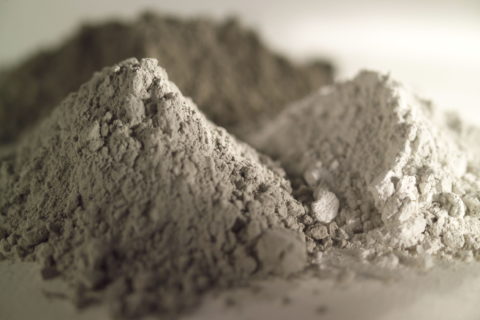 Cement
Cement
Portland cement is the main binder. PCM400, PCM500 less often PCM300. The composition of the remaining components directly depends on the dosage and grade of cement.
For a higher quality mixture, a mixture without additives is preferable. But, for M200, the use of a binder with additives is allowed. Moreover, their content will be reflected in the labeling, for example, PCM400D0 and PCM500D20.
When buying cement, ask the manufacturer for a quality certificate for it
Pay attention to the date of manufacture. It is a perishable product of the construction industry.
A month after release, even in a sealed package, it begins to slowly lose its qualities. And if it contains hard stones, even of a small size, then you have a poor-quality product, and it is not recommended to work with it.
 Clogged products
Clogged products
Sand
 Construction sand
Construction sand
The sand acts as a fine aggregate. It is advisable to purchase pure river sand with a fineness modulus of 2.0-2.5 (medium coarseness).
If it contains foreign inclusions, in particular lumps of clay, it will not work like that. Dirt, dust and clay simply "eat up" some of the characteristics of the future material at the stage of cement hydration.
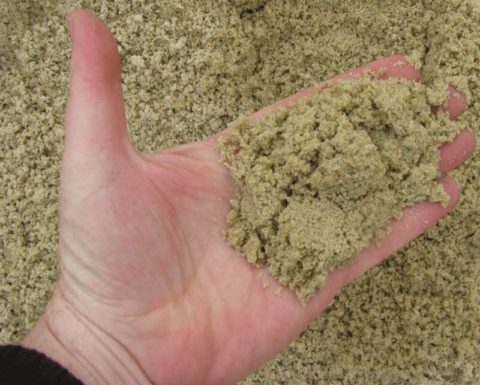 Clean sand
Clean sand
Crushed stone
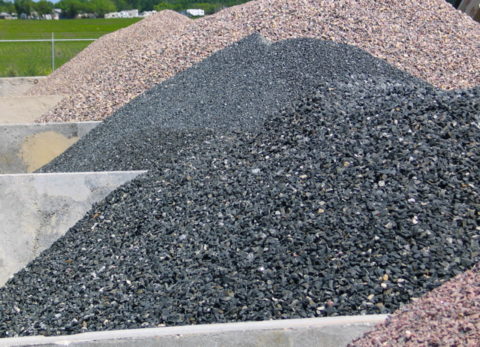 Bulk storage of crushed stone of various grades
Bulk storage of crushed stone of various grades
Cuboid crushed stone is the ideal coarse aggregate for creating M200 concrete. The composition and proportions depend on the size modulus.
For the brand in question, it is necessary to take crushed stone or gravel with a particle size of 10-20. If there is an opportunity to get a granite aggregate, then be sure to take this opportunity.
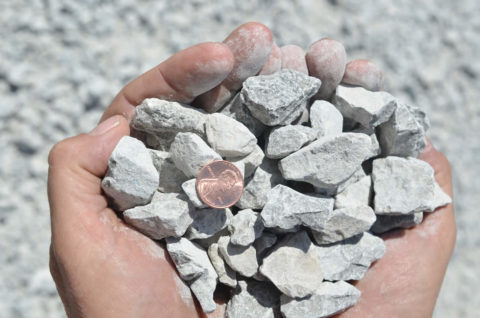 Cuboid crushed stone
Cuboid crushed stone
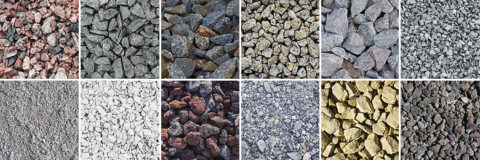 Different types of rubble
Different types of rubble
Plasticizer
 Tile with plasticizer
Tile with plasticizer
If it is required to increase the plasticity, strength, frost resistance, crack resistance, adhesion to the reinforced cage, to give the properties to work at subzero temperatures, then one cannot do without special plasticizers.
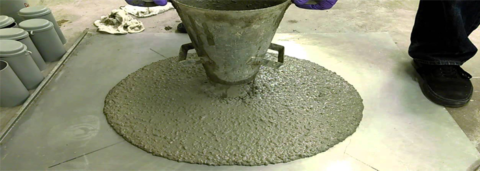 Increase workability with a plasticizer
Increase workability with a plasticizer
They are dosed according to the attached instructions from the amount of cement. Of course, the price for it is decent, but it will fully pay off with high quality.


